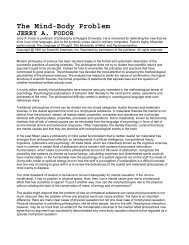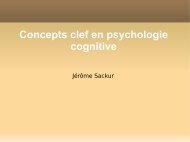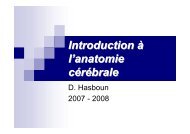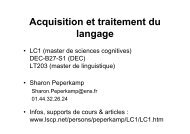From single to multiple deficit models of developmental disorders
From single to multiple deficit models of developmental disorders
From single to multiple deficit models of developmental disorders
You also want an ePaper? Increase the reach of your titles
YUMPU automatically turns print PDFs into web optimized ePapers that Google loves.
390 B.F. Penning<strong>to</strong>n / Cognition 101 (2006) 385–413<br />
and genetic overlap between dyslexia and ADHD. Then I will review what we know<br />
about their cognitive overlap and then discuss how what we have learned about this<br />
comorbidity argues for a <strong>multiple</strong> deWcit model over a <strong>single</strong> cognitive deWcit model.<br />
3.1.1. Symp<strong>to</strong>m overlap<br />
Dyslexia and ADHD co-occur more frequently than would be expected by chance<br />
and this comorbidity is found in both clinical and community samples. Across studies,<br />
around 25–40% <strong>of</strong> children with either dyslexia or ADHD also meet criteria for<br />
the other disorder (August & GarWnkel, 1990; Dykman & Ackerman, 1991; Semrud-<br />
Clikeman et al., 1992; Willcutt & Penning<strong>to</strong>n, 2000).<br />
Two artifactual explanations <strong>of</strong> this comorbidity can be rejected. Because the<br />
comorbidity is found in community samples, it is not due <strong>to</strong> a selection artifact (e.g.,<br />
Berkson’s bias). Because dyslexia is deWned by cognitive tests whereas ADHD is<br />
deWned by behavior ratings (usually from teachers and parents), the comorbidity is<br />
not due <strong>to</strong> deWnitional overlap.<br />
3.1.2. Apparent cognitive independence<br />
We began our studies <strong>of</strong> the relation between dyslexia and ADHD using a <strong>single</strong><br />
cognitive deWcit model. Since there was evidence for distinct cognitive deWcits underlying<br />
each disorder, we hypothesized there ought <strong>to</strong> be a double dissociation between<br />
them. Dyslexia would have a phonological deWcit but not an executive deWcit,<br />
whereas ADHD would have an opposite proWle: an executive deWcit but not a phonological<br />
deWcit. To explain their surprising comorbidity, we hypothesized that dyslexia<br />
as a primary disorder caused just the symp<strong>to</strong>ms <strong>of</strong> ADHD, which is the<br />
symp<strong>to</strong>m phenocopy hypothesis (an example <strong>of</strong> one <strong>of</strong> Neale & Kendler’s, 1995, multiformity<br />
<strong>models</strong>).<br />
We tested both the hypothesized double dissociation between the two pure <strong>disorders</strong><br />
and the symp<strong>to</strong>m phenocopy hypothesis using a 2 £ 2 design in which ADHD<br />
(presence vs. absence) was crossed with dyslexia (presence vs. absence), yielding four<br />
groups: those with neither disorder (controls), those with dyslexia only or ADHD<br />
only, and those with both <strong>disorders</strong> (comorbid group). We gave these groups <strong>multiple</strong><br />
measures <strong>of</strong> phonological processing and executive functions and compared their<br />
performance across the two resulting cognitive composites (Penning<strong>to</strong>n et al., 1993).<br />
We found the hypothesized double dissociation and a proWle in the comorbid group<br />
that Wt the symp<strong>to</strong>m phenocopy hypothesis: the comorbid group was impaired on the<br />
phonological composite but not on the executive composite. Hence, this comorbid<br />
group had the symp<strong>to</strong>ms <strong>of</strong> ADHD, but not the underlying executive deWcit, as the<br />
phenocopy hypothesis would predict. So, these results Wt a <strong>single</strong> deWcit model <strong>of</strong><br />
each disorder.<br />
But subsequent studies using this same design (Nigg, Hinshaw, Carte, & Treuting,<br />
1998; Reader, Harris, Schuerholz, & Denckla, 1994), including one <strong>of</strong> our own (Willcutt<br />
et al., 2001), did not replicate the Penning<strong>to</strong>n et al. (1993) result for the comorbid<br />
group, although they generally replicated the double dissociation found between the<br />
two “pure” groups. The comorbid group in these subsequent studies had a generally<br />
additive combination <strong>of</strong> the deWcits found in each pure group. That is, they had both







